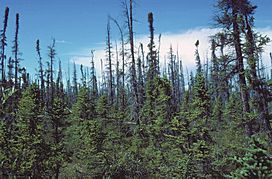Hudson Plains Ecozone (CEC) facts for kids
Quick facts for kids Hudson Plains |
|
|---|---|

Black Spruce (Picea mariana) forest typical of this ecozone
|
|
| Ecology | |
| Borders | Boreal Shield, Southern Arctic and Taiga Shield |
| Geography | |
| Area | 373,718 km2 (144,293 sq mi) |
| Country | Canada |
| Provinces | Manitoba, Nunavut, Ontario and Quebec |
| Climate type | Subarctic |
The Hudson Plains Ecozone is a huge natural area in Canada. It stretches along the coasts of James Bay and southern Hudson Bay. This special place covers parts of Manitoba, Nunavut, Ontario, and Quebec. It's known for having the largest continuous wetland in the world! This means it's a very wet area with lots of bogs and marshes.
This ecozone covers about a quarter of Ontario's land. It makes up about 3.6% of all of Canada. The total area is around 369,000 square kilometers of land. It also includes 11,800 square kilometers of water.
Long ago, brave explorers faced tough conditions here. They built forts for the Hudson's Bay Company. There were also wars between France and Britain in this region. Today, the Hudson Plains are famous for Polar Bear Provincial Park. They are also known for Wapusk National Park. Many migratory birds use its vast wetlands as a resting and feeding spot.
Contents
Geography of the Hudson Plains
The land here is mostly flat and low. It was formed by old layers of rock and soil. The highest points are rarely more than 120 meters above sea level. The land gently slopes towards Hudson Bay and James Bay. These bays collect all the water from the region.
Because the land is so flat, water does not drain away easily. This has led to many natural wetlands forming. The Hudson Plains are surrounded by the Canadian Shield. In some places, they even overlap with it.
Where the Ecozone is Located
To the north, the Hudson Plains meet the very cold Arctic Archipelago Marine ecozone. To the south, it borders the milder Boreal Shield. This means the Hudson Plains are a "transition zone." You can see this change clearly. In the north, the land is almost like a tundra with few trees. As you go south, it changes into open taiga forests. These forests look like the boreal zone, but with fewer plants.
Lakes and Coastal Areas
Thousands of dips in the land were made by melting glaciers. These dips have become many lakes and wetlands. The Hudson Plains also have coastal marshes. There are huge flat areas along the coast where the tide goes in and out. These are called tidal flats. You can also see lines of raised beaches. These show where the land has risen after the heavy glaciers melted away.
Main Sections of the Ecozone
This large ecozone can be divided into two main parts:
- Hudson Bay Coastal Plains
- Hudson-James Lowlands
Climate of the Hudson Plains
The Hudson Plains have a subarctic climate. This means it's generally cold. The nearby Hudson Bay greatly affects the weather. It brings cold, moist air with low pressure. Very cold air masses from the North Pole often reach this area.
Temperatures and Precipitation
In January, the average temperature is around -19°C. In July, the average temperature is between 12°C and 16°C. The region gets a moderate amount of rain and snow. This is usually between 400 mm and 700 mm each year. Summers are cool and quite short. Winters are very cold and long.
Flora and Fauna: Plants and Animals
The Hudson Plains are known for having many insects. These insects are a big food source for waterbirds that migrate here. The area is famous for its large numbers of biting insects.
Plant Life
Plant life is somewhat limited here. The northern parts, near the Arctic, have almost no trees. The southern parts, next to the Boreal Shield, have open forests. Common plants in the wet bogs and fens include Alder, willow, black spruce, and tamarack. In the open bogs to the north, you'll find sphagnum moss and shrubs like crowberry and blueberry. White spruce trees appear more often further south. Areas that don't drain well have thick covers of sedge, moss, and lichen.
Animal Life
The Hudson Plains are the southern end of the polar bears' yearly journey. Polar bears travel to the northwestern coast of Ontario. In autumn, they move to the ice that forms along the Hudson Bay coast. The bears then follow the coast towards Churchill, Manitoba.
Other large Mammals like moose, woodland caribou, and black bears live comfortably here. Smaller mammals are also common. These include muskrats, weasels, Arctic foxes, martens, and fishers.
The nearby marine area has its own animals. You can find walrus and different types of seals there. These include bearded, harbour, and ringed seals.
Birds and Migration
Millions of shorebirds stop and nest in the Hudson Plains. This is especially true in three areas within Southern James Bay. These places are Akimiski Island, and the bird sanctuaries at Hannah Bay and the mouth of the Moose River. Some of the birds you might see include the snow goose, Canada goose, king eider, swan, loon, gyrfalcon, and peregrine falcon.

